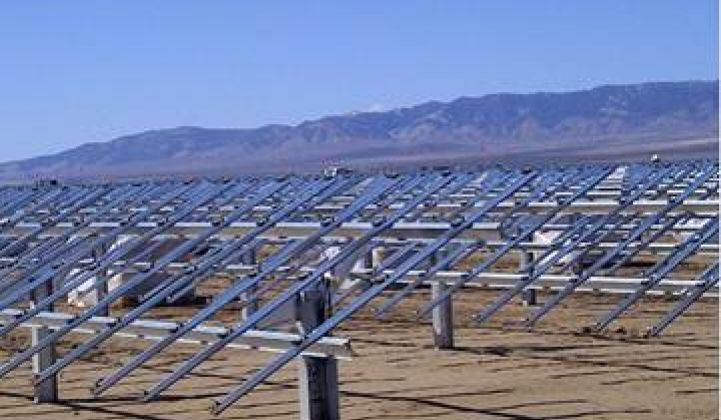The 230-megawatt Antelope Valley Solar Ranch One (AVSR1) photovoltaic power plant being built for Exelon Corporation (NYSE: EXC) by First Solar (Nasdaq: FSLR) is facing some challenges.
Exclusively to GTM, Assistant Los Angeles County Supervisor Norm Hickling confirmed rumors of “a large layoff” affecting the AVSR1 workforce on Friday. “I also understand that negotiations continue,” Hickling added about attempts to settle the dispute between First Solar and LA County that has put the project six weeks behind schedule, with “little progress.”
Approximately 120 of the current 240-person workforce was “furloughed,” according to First Solar Public Relations Director Alan Bernheimer.
This is a severe blow to an already jobs-poor Los Angeles-adjacent community where recent studies found as many as one in three homeowners behind and/or underwater with their mortgages.
Negotiations began in early April after an LA County safety inspector discovered that electrical connections on the 3.7 million First Solar cadmium telluride (CdTe) thin-film photovoltaic panels that were to be used at the site could not be approved by LA County Building and Safety officials, according to County spokesperson Kerjon Lee.
The Conditional Use Permit granted to First Solar by LA County specifies that electrical installations “shall be designed in accordance with the National Electric Safety Code [NESC] or in accordance with other standards or regulations acceptable to the building official.”
The NESC, Bernheimer informed GTM by email, “recognizes IEC certifications for 1000 V systems. First Solar modules are IEC 61646 and IEC 61730 certified for such use.”
Neither the company nor the county would specify how these facts led to work being stopped at AVSR1 or why the impasse has lasted six weeks.
The inspector was reportedly doing a routine site visit, in service to the County’s conditional use permit (CUP) for the solar power plant, when he discovered the problem with the panels’ electrical connections. The problem has apparently not been at issue or was not noticed in other states, such as Nevada, where First Solar has done thin film installations, and it is also a standard to which First Solar has not been held at installations it has done elsewhere in California.
_540_449_80.jpg)
Neither the County nor First Solar have offered many details. “The Los Angeles County Public Works Department,” County spokesperson Bob Spencer told GTM when negotiations began, “is working with First Solar to address its plan check comments relative to the rating of the modules and the applicable electrical safety regulations.”
“First Solar is in discussions with Los Angeles County Public Works regarding electrical codes and standards interpretations as they relate to utility-scale, solar photovoltaic (PV) installations,” First Solar spokesperson Ted Meyer told GTM at that time. “We are confident these discussions will result in a satisfactory resolution.”
That was six weeks ago.
“Our discussions with the county are ongoing and we are working to resolve the issue so we can put people back to work,” Bernheimer told GTM Saturday.
First Solar's Adam Eventov told the Oso Town Council on Thursday night a settlement was expected by mid-June but noted, in the same statement, that problems with dust were preventing the company from continuing to grade land and prepare racks for panel installation at the project site. A proposal to use decomposed granite to minimize dust had been blocked by the County, Eventov said, leaving them with only the expensive alternative of hydroseeding.
Eventov also said that First Solar has, as promised, made a $140,000 donation to Antelope Valley College on behalf of the AVSR1 project but continues to hold a matching donation to the local communities until panel installation can continue.
At the same meeting, elected members of the Oso Town Council Richard Skaggs and Gerry Conroy, just back from the annual First Solar shareholder meeting in Phoenix, reported to the community that they thought the County was more responsible for impediments to continued construction than the company.
_540_449_80.jpg)
Panel installation was scheduled to begin at AVSR1 by mid-April. If the panels cannot be approved until UL certification is obtained or replacement with another technology becomes necessary, the financial consequences for First Solar could be problematic to the already financially hamstrung company. First Solar’s share price was as high as $140 in July 2011 but now hovers around $15.
First Solar continues to be in charge of engineering, procurement and construction (EPC) at the site. It is also in charge of EPC at the NRG Energy Alpine Solar project located a few miles away, which, like AVSR1, would use the problematic panels and is subject to provisions of an LA County CUP.
The total number of panels that will require some kind of attention or adjustment is well in excess of four million.
Neither the County nor First Solar would comment on whether corrections at other First Solar projects in development or retroactive corrections of panels at other California sites will be necessary.
Also under development with First Solar as panel supplier and in the EPC role and -- therefore potentially affected by this issue -- are the 550-megawatt Topaz Solar Farm in San Luis Obispo County owned by MidAmerican Holdings and the 550-megawatt Desert Center Solar Farm in Riverside County owned by NextEra Energy and GE.
The 21-megawatt Blythe Solar Project in Riverside County owned by NRG Energy may also be affected.
With a power supply uncertainty looming due to the safety issues that took the 2,200-megawatt Son Onofre Nuclear Generating Station (SONGS) off-line, it would have been a positive result for Southern California if AVSR1 was coming on-line this summer.



